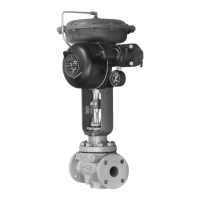Instruction Manual
D200108X012
546 Transducer
March 2015
13
Maintenance
Maintenance of the transducer consists of relay repair or replacement, and replacement of the feedback bellows.
WARNING
The following maintenance procedures require that the transducer be taken out of service. This requires that certain
precautions be taken to avoid personal injury or equipment damage caused by sudden release of pressure. Prior to
maintenance:
D Always wear protective clothing, gloves, and eyewear when performing any maintenance procedures to avoid personal
injury.
D Disconnect electrical power before removing the transducer cover.
D Shut off or disconnect pressure lines to the transducer.
D Disconnect any operating lines providing air pressure, electrical power, or a control signal to the actuator. Be sure the
actuator cannot suddenly open or close the valve.
D Use bypass valves or completely shut off the process to isolate the valve from process pressure.
D Do not remove the actuator from the valve while the valve is still pressurized.
D Relieve process pressure on both sides of the valve.
D Vent the power actuator loading pressure and relieve any actuator spring precompression.
D Use lock‐out procedures to be sure that the above measures stay in effect while you work on the equipment.
D Check with your process or safety engineer for any additional measures that must be taken to protect against process
media.
WARNING
For explosion proof applications, disconnect power before opening the transducer cover. Personal injury or property
damage may result from fire or explosion if power is not disconnected.
CAUTION
The presence of Emerson Process Management personnel and also approval agency personnel may be required if you
service (other than normal, routine maintenance, such as calibration) or replace components on a transducer that carries a
third‐party approval. When you replace components, use only components specified by the factory. Substitution with
other components may void the third‐party approval. Also, always use proper component replacement techniques, as
presented in this manual. Improper techniques can cause poor quality repairs and impair the safety features of the device.
Figure 9 shows the torque motor and associated parts. Shaded key numbers indicate parts that should not be
disassembled from the torque motor because the magnetism in the torque motor magnets will decrease
permanently.
Certain troubleshooting and alignment procedures are described at the end of this section. These may serve as a guide
to correct some problems. Improper supply pressure and mechanical defects in pneumatic and electrical connections
should be apparent upon inspection and repaired as appropriate.

